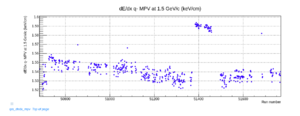Difference between revisions of "Start Counter Operations 2018Fall"
From GlueXWiki
(→Start Counter Performance Fall 2018) |
(→Start Counter Performance Fall 2018) |
||
| (One intermediate revision by the same user not shown) | |||
| Line 1: | Line 1: | ||
==== Start Counter Performance Fall 2018 ==== | ==== Start Counter Performance Fall 2018 ==== | ||
| − | The gain and performance of the Start Counter paddles is rather constant over the fall of 2018 with the exception of a small period where the run conditions were quite different. This was the period with very low intensity running, 40nA of e-beam current rather than the usual 200nA. This is demonstrated by looking at the dEdx data from the start counter as a function of run number. During the low intensity running the gain was about | + | The gain and performance of the Start Counter paddles is rather constant over the fall of 2018 with the exception of a small period where the run conditions were quite different. This was the period with very low intensity running, 40nA of e-beam current rather than the usual 200nA. This is demonstrated by looking at the dEdx data from the start counter as a function of run number. During the low intensity running the gain was about 4% higher.<br> |
| − | [[File:sc_dedx_fall2018.png| 300px]] | + | [[File:sc_dedx_fall2018.png| 300px]] <br> |
| + | |||
| + | Exhibiting such a clear dependency of photon flux is unexpected for SiPM operations. There is no gain variation expected for different hit rates within reasonable limits of course. | ||
Latest revision as of 18:33, 24 September 2024
Start Counter Performance Fall 2018
The gain and performance of the Start Counter paddles is rather constant over the fall of 2018 with the exception of a small period where the run conditions were quite different. This was the period with very low intensity running, 40nA of e-beam current rather than the usual 200nA. This is demonstrated by looking at the dEdx data from the start counter as a function of run number. During the low intensity running the gain was about 4% higher.

Exhibiting such a clear dependency of photon flux is unexpected for SiPM operations. There is no gain variation expected for different hit rates within reasonable limits of course.